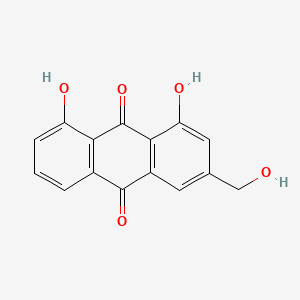Aloe Emodin



| Name | Aloe emodin | ||
| PubChem CID | 10207 | ||
| Molecular Weight | 270.24g/mol | ||
| Synonyms |
Aloe Emodin |
||
| Formula | C₁₅H₁₀O₅ | ||
| SMILES | C1=CC2=C(C(=C1)O)C(=O)C3=C(C2=O)C=C(C=C3O)CO | ||
| InChI | 1S/C15H10O5/c16-6-7-4-9-13(11(18)5-7)15(20)12-8(14(9)19)2-1-3-10(12)17/h1-5,16-18H,6H2 | ||
| InChIKey | YDQWDHRMZQUTBA-UHFFFAOYSA-N | ||
| CAS Number | 481-72-1 | ||
| ChEMBL ID | CHEMBL40275 | ||
| ChEBI ID | CHEBI:2607 | ||
| KEGG ID | C10294 | ||
| Structure | 
|
Download
2D
MOL
3D
MOL
|
|
| Chineses Pinyin | BoHe | ||
| Use Part | Aerial Parts | ||
| Habitat | JiangSu | ||
| Flavor | Pungent | ||
| Meridian Tropism | Lung, Liver | ||
| Species |
>Kingdom: Viridiplantae
-->Phylum: Streptophyta
-->Class: Equisetopsida
-->Order: Lamiales
-->Family: Lamiaceae
-->Genus: Mentha
-->Species: Mentha haplocalyx
|
||
| Chineses Pinyin | LuHui | ||
| Use Part | Solid residue obtained by evaporating liquid which drains from leaves | ||
| Flavor | Bitter | ||
| Meridian Tropism | Liver; Stomach; Large Intestine | ||
| Species |
>Kingdom: Viridiplantae
-->Phylum: Streptophyta
-->Class: Equisetopsida
-->Order: Asparagales
-->Family: Asphodelaceae
-->Genus: Aloe
-->Species: Aloe vera
|
||
| Pair Name | Aloe emodin, Gefitinib | |||
| Partner Name | Gefitinib | |||
| Disease Info | [ICD-11: 2C25.Z] | Lung cancer | Investigative | |
| Biological Phenomena | Inhibition-->Epithelial-mesenchymal transition | |||
| Gene Regulation | Down-regulation | Expression | SLC22A3 | hsa6581 |
| Down-regulation | Expression | PIK3CA | hsa5290 | |
| Down-regulation | Expression | AKT1 | hsa207 | |
| In Vitro Model | PC-9 | Lung adenocarcinoma | Homo sapiens (Human) | CVCL_B260 |
| PC-9-GR-high | Lung adenocarcinoma | Homo sapiens (Human) | CVCL_S706 | |
| In Vivo Model | After acclimated for one week, subcutaneous inoculation of 1×10⁷ PC9-GR cells was executed into the right flank of the animals (n = 4 in each group) to develop xenograft models. | |||
| Result | AE could enhance the gefitinib sensitivity of PC9-GR cells and reverse EMT by blocking PI3K/Akt/TWIS1 signal pathway. | |||
| Pair Name | Aloe emodin, Doxorubicin | |||
| Partner Name | Doxorubicin | |||
| Disease Info | [ICD-11: 2C60] | Breast cancer | Investigative | |
| Biological Phenomena | Induction-->DNA damage | |||
| Gene Regulation | Down-regulation | Activity | ABCB1 | hsa5243 |
| Up-regulation | Cleavage | CASP3 | hsa836 | |
| In Vitro Model | MCF-7 | Invasive breast carcinoma of no special type | Homo sapiens (Human) | CVCL_0031 |
| Result | Our study indicated that AE could be a potential reversal agent to resensitize ADR resistant in tumor chemotherapy and inhibiting autophagy might be an effective strategy to further enhance the reversal activity of AE. | |||
| Pair Name | Aloe emodin, Temozolomide | |||
| Partner Name | Temozolomide | |||
| Disease Info | [ICD-11: 2A00] | Glioblastoma multiforme | Investigative | |
| Biological Phenomena | Induction-->Apoptosis | |||
| Gene Regulation | Down-regulation | Expression | MGMT | hsa4255 |
| Down-regulation | Expression | NFKB1 | hsa4790 | |
| In Vitro Model | IRCC-Neuromed-NULU | Glioblastoma | Homo sapiens (Human) | CVCL_B1D1 |
| IRCC-Neuromed-ZAR | Glioblastoma | Homo sapiens (Human) | CVCL_B1CY | |
| Result | These convincing results suggest that AE could be a natural adjuvant agent to potentiate the effects of traditional drugs (TMZ) and overcome drug resistance in glioblastoma cells. | |||
| No. | Title | Href |
|---|---|---|
| 1 | Sensitization of Non-Small Cell Lung Cancer Cells to Gefitinib and Reversal of Epithelial-Mesenchymal Transition by Aloe-Emodin Via PI3K/Akt/TWIS1 Signal Blockage. Front Oncol. 2022 May 23;12:908031. doi: 10.3389/fonc.2022.908031. | Click |
| 2 | The effects and mechanisms of aloe-emodin on reversing adriamycin-induced resistance of MCF-7/ADR cells. Phytother Res. 2021 Jul;35(7):3886-3897. doi: 10.1002/ptr.7096. | Click |
| 3 | Aloe-Emodin Overcomes Anti-Cancer Drug Resistance to Temozolomide and Prevents Colony Formation and Migration in Primary Human Glioblastoma Cell Lines NULU and ZAR. Molecules. 2023 Aug 11;28(16):6024. doi: 10.3390/molecules28166024 | Click |
